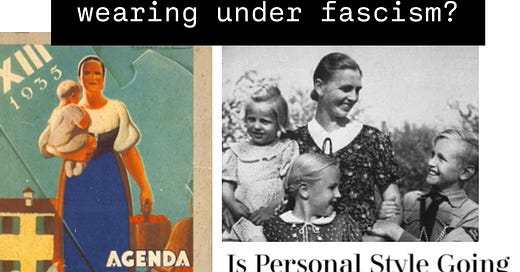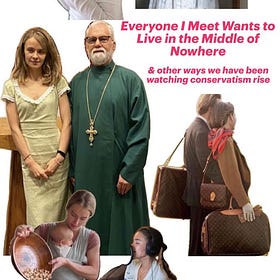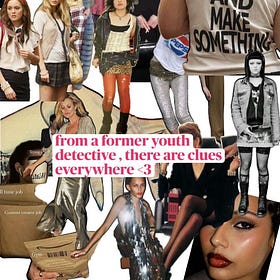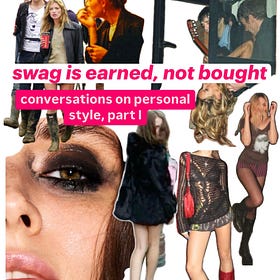We are manipulated through fashion and the lens through which it is reported.
I’ve said this before, but we are watching fascism unfold through clothing and cultural trends. Women are the key subjects in this because they always have been. There has always been a relationship between fashion, style, and politics. We just see it unravel a little differently with “content” and social media culture. The fascist way of dressing always varies by era, but a regime uses fashion to create a unified look that showcases control and does not embrace “boldness”.
Fashion, relating to trending and easily purchased clothing, is in everyone’s life one way or another. Fashion is a vessel for propaganda and what we are being fed is fascism. Fashion, on the simplest terms, is a very easy way to control a narrative of the masses.
Tiktok wasn’t banned, but it’s not going to last long, it’s over. Goodbye to certain hashtags, live feeds during massive protest waves around the world, and goodbye possibly the art of fashion itself? In 1933, Hitler wanted “no more Paris models”, and while I’ve written about how the election of Trump and the rise of the conservative moment was easily predicted through fashion and content trends of the last two years, and while many can see that and draw their own connections, I don’t think we understand truly what those years of obsession with ED culture and extremely thin models, and Trad Wife style content means for our future. Fashion is a form of propaganda, maybe the biggest form, but it is more complex than just that.
Everyone I Meet Wants to Live in the Middle of Nowhere
I’m about to show some tough love to y’all – it’s been pretty obvious what path we’ve been heading down. From Trad Wife influencers and wellness obsessions to the rise of ED culture and our fixation on toxins in food and even in clothing, it was only a matter of time before we elected a more fascist-leaning party and began moving backward. I think many …
Fashion production continued under the Nazi control, but it came with higher hemlines, slender forms forcing slender bodies, and uncomfortable wooden shoes. Can you think how this relates to modern day? If not, let me show you: a form of a high, high heel so that women can’t run as fast, long dresses to showcase feminine modesty as an idealized Little House on the Prairie prize for a man’s house, uniform dressing so one doesn’t cause waves of any kind, clean girl this, stay-at-home gf that. We know dressing modestly isn’t necessarily something that equals control, and I wear heels sometimes, who doesn’t? I enjoy dressing like a slut in uncomfortable shift dresses. My personal style is usually viewed as very Americana, hell I cited Little House on the Prairie as some of my og fashion inspiration. While all of this isn’t fascism, our fashion and aesthetics reflect social and political trends. They don’t equal each other, but they are in conversation.
Women under fascism are encouraged to not move too loudly or boldly through the world. They are meant to follow. They are meant to look their best, keep their figure, support the country and the men in power, create a new generation of this pattern. Coco Chanel, a known fascist, produced luxury goods and fashion in a way many had never seen before, but it was still fascist. Appeals to luxury are especially heightened during times of rising conservative and fascist power, and times of extremely unequal wealth, to show their own wealth and spark other’s desire for it. Chanel was obsessed with women’s bodies fitting the clothing and not clothing fitting women’s bodies, sparked a trend of control that still plays in today’s industry. Our fixation on elitism and luxury goods (through popular aesthetics) only furthers our isolation from uniting under a community against a fascist power - when we all strive to be something that is almost unreachable for the average working class citizen, we divide ourselves in the desire to reach it.
But even during the Nazi reign, there was protest by women who wore shorter skirts and turbans. There is always rebellion within fashion, as fashion is something that is around everyone in one form or another. When there is a pressure to dress a certain way, there is always a rebellion in the opposite. But what does our rebellion of dressing look like, when our isolation as a whole is very high in this country? When we are forced onto online social platforms that are mass-controlled by Meta (and who knows what Tiktok is controlled by now, but we might have some clues) because we are in the “aftermath” of a worldwide pandemic and have been craving socialization and community in any form? Because we are forced to work 2-3 jobs to make our rent for the month and have no time to physically attend social gatherings and clubs and spaces?
We see our Meta platforms as a “necessary evil”, which we will also soon, most likely, be associating Tiktok with. Another sign of early rising fascism is mass controlled media and these “necessary evils” are ending fact checking and DEI efforts, prompting further misinformation and hate to be easily spread throughout the apps. When our fashion is dictated by online trends and aesthetics, it’s right-wing social media owners that are controlling the narrative. Every time I have been called for an interview for a fashion publication, it’s through been through someone seeing a Tiktok video of mine. Fashion trend forecasters gain fame and creditability through sharing takes on apps. The quickest way to fame is not through anything besides being online in social media platforms, that often have their algorithms tied to conservative backing. We think we have the freedom to share our ideas and our takes on fashion, but do we really have the freedom we think we do? Or is our story being narrated for us by someone else? Where does our new wave of rebellious dressing begin, does it truly begin online?
Two very large signs of fascism are when a leader uses violence to create order and obedience, and when a leader focuses in on scapegoats. There is leaked information ICE raids happening in major cities tomorrow, Jan. 21st - that I must share in this post incase this is news to you.
Maybe everyone’s trend prediction of “gatekeeping” (and one of my predictions) is true but in a way we didn’t realize. Sure there’s the gatekeeping of elitist aesthetics. But maybe the more important gatekeeping is of the people from the powerful: in the form of people mass migrating to decentralized community-minded platforms? Maybe it’s the act of gatekeeping your online presence from the corporations that profit from your attention on the apps? Maybe it’s wanting to control your own narrative?
To fight fascism requires direct action. Prioritize that. But since fashion is political, remember that having your personal style outside of aesthetics and trends resists the way fashion controls us. I’m planning on restarting a “street style” series on this blog to celebrate individuals with no knowledge of their online presence, platform, career, or even name (until I talk to them) mainly at non-fashion related events or public spaces. Actual personal style, not marketed personal style we have seen this year, is something that can’t be sold to you, which I have written about many times and highlighted here, if you’d like to read more.
Swag is Earned, Not Bought (Conversations on Personal Style, Part I)
We have always had an obsession with “personal style”. How do you find it? How do you curate it? How do you have "better” “personal style” than others?
Showcasing personal style doesn’t make you buy anything, it’s not “content” it’s not trends, it is art. And art scares fascists because they cannot control it. I want to showcase people, I want to talk about clothing choices with people in the most non-content way I can think of sharing it — with lots of great “protest” looks.
I want to showcase that the death of personal style did not come in 2024. That is conservative signaling in itself - if we let people tell the story that it is gone, we have more room to stop expression and boldness.
Y’all wake up. And really ask yourself this “What will you be wearing under fascism?”
The people have a lot to showcase. There is no death of personal style. We know that fashion is more than just clothing or trends - it’s a powerful tool, which can dictate many spaces of our lives besides our closets - fashion is something that can unite us. It can unite us under fascist control, or it can be a way of protest and bringing people together while controlling your own consumption of ideas of fashion being sold to you.








I genuinely thought fraught times would come with a lot more latex outfits and fun cutouts... but alas here we are surrounded by lower hemlines.
This inspired me to call up my friend who mends clothes and set a date for them to teach me 💫 in 2025 i will have the ability to sustain my own clothes as resistance